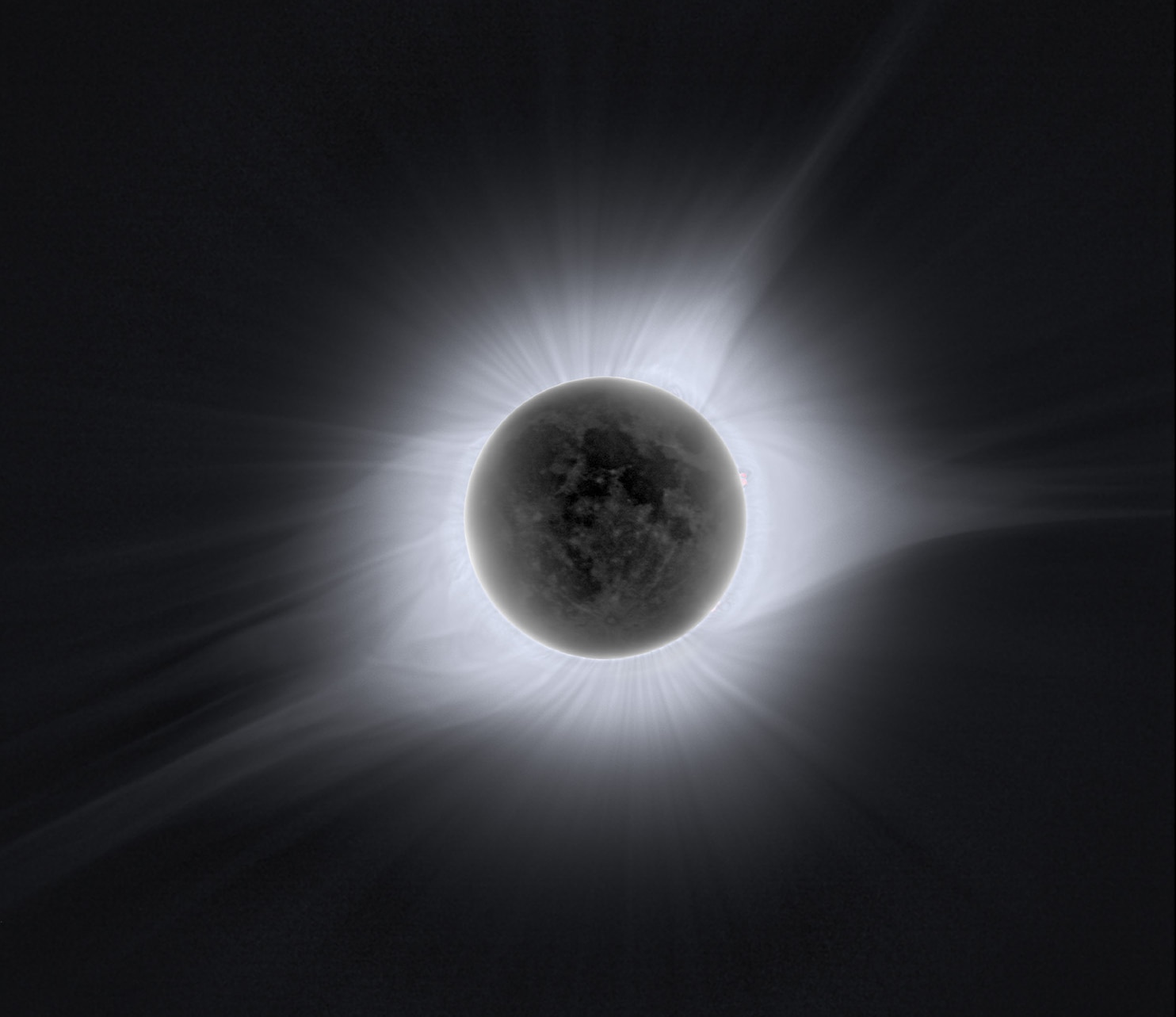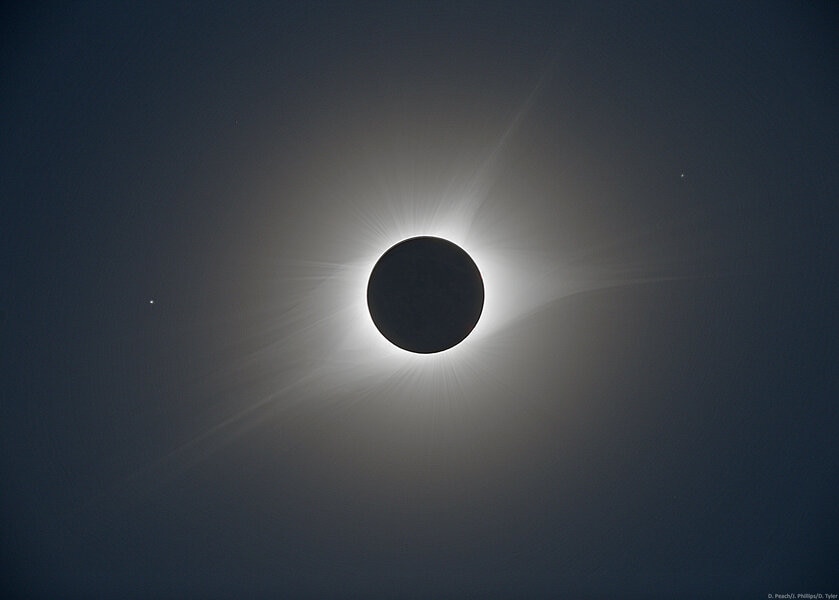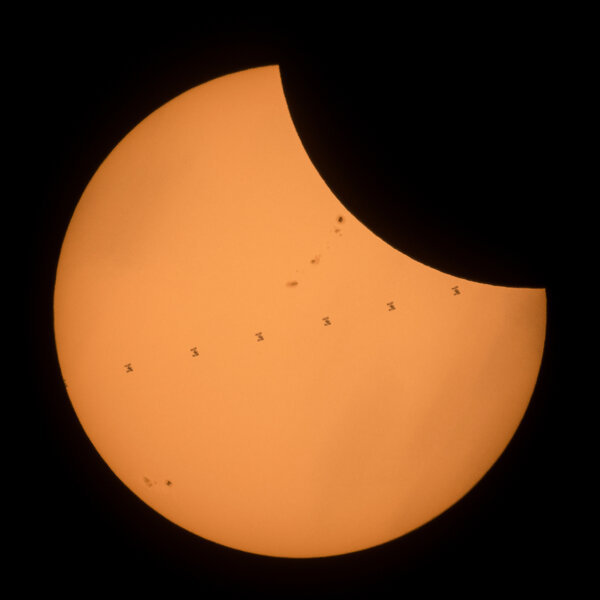When the Moon ate the Sun

Last week, on August 21, 2017, the stars aligned. Well, one star, and a moon. Specifically, our star and our moon: The Moon’s orbit brought it in exact alignment with the Sun in the sky, causing a solar eclipse.
The shadow of the Moon swept across the continental United States, and a lot of people flocked to the path of totality to watch it. My wife and I were two of them; we brought about 30 people to a ranch near Dubois, Wyoming, to view the eclipse as part of our Science Getaways vacation company.
My wish for this event was that, besides the usual (but of course still astonishing) views of the eclipse, we'd see some odd sights from the millions of people who took photos. That turns out to have been the case. Let me show you just a few …
First, I have the video "Stormhenge" by astrophotographers Harun Mehmedinović and Gavin Heffernan (the creators of the Skyglow project). They traveled to Nebraska to get footage at Carhenge, 39 cars assembled to create a scaled version of Stonehenge. Yes, you read that right. There's a whimsy to this video (which I found strangely amplified by the dramatic music) that ends with a truly wonderful set of shots of The Main Event. Watch:
I remember writing about this eclipse some time ago, and someone asked me why it was being called "an American eclipse." Besides the obvious — the path of totality crossed the U.S., so it was only able to be seen from here — I think gatherings at places like Carhenge made it uniquely American.
An aspect of the eclipse that surprised me has to do with the geometry. When the Moon is exactly in front of the Sun, we are seeing the Moon's dark side, the half of it not lit by the Sun. In general, that would mean the Moon's surface is itself invisible; after all, it's very dark, and even though the surface of the Sun is blocked, the Sun's corona, its outer atmosphere, is bright (about as bright as the full Moon, actually), and the sky around it is bright as well.
But it's possible sometimes to see the "dark" side of the Moon. If you were standing on the dark part of the Moon, the Sun is not in the sky (it's your nighttime), but there's another illumination source: the Earth. Our planet appears 16 times the area in the sky as the Moon does from Earth, and it reflects sunlight better, too, making it as much as 50 times brighter than the full Moon seen from Earth. That means the dark side of the Moon is illuminated by the Earth, and we call this effect "Earthshine" (or, more poetically, the old Moon in the new Moon's arms). It's still faint and overwhelmed by the corona, but it can be shown in longer-exposure photos. Astronomer Adam Block took multiple exposure of the eclipse and combined them to show both the bright corona and the faint Earthlit Moon:
Whoa. You can see the lunar surface even though it's thousands of times fainter than the structures around the Sun! That’s because this image is constructed from many photographs taken at exposure times of 2 seconds, 1 second, ¼, 1/60th, and 1/2000th of a second. The short exposures reveal the solar features like the corona and a few towering prominences of hydrogen gas erupting from the surface, while the long ones show very dark lunar maria and even a few craters like Tycho at the lower center.
Astrophotographer Damian Peach used a similar method, and processed the result to show some interesting things in his image:
Some lunar features are very faintly visible, but in this wider shot you can also see the stars Regulus (to the left) and Eta Leonis (upper right). I love how the sharpened image shows delicate streamers in the corona, caused by the Sun's powerful magnetic field driving gas into space. Peach said this is a "quickly processed" image, and he'll be working more on this image. Given how beautiful this one is, I can't wait to see how it turns out!
Another good view was seen not from Earth, but from space. The Deep Space Climate Observer (or DSCOVR) satellite orbits 1.5 million kilometers above the Earth in the direction of the Sun, facing our planet and snapping an image about once per hour. For the eclipse, however, scientists and engineers commanded the spacecraft to take them faster, creating a series of a dozen still images over the course of the event (they did this for a 2016 eclipse as well). The folks at Blueturn used software to smoothly interpolate and animate the images, creating this lovely video:
The original NASA video shows the same animation without the smoothing. It's amazing to watch the Moon's shadow moving across our planet; I was struck by how the motion is clearly mostly due to the Moon's own orbital velocity as it circles the Earth. The Earth's rotation is in the same direction, actually extending the duration of the eclipse for an observer on the surface. If the Earth didn't spin the shadows would move faster along the ground, and conversely if the Moon's motion were slow enough, the Earth's rotation would sweep the eclipse shadow from east to west, backwards from how we see it now! It's fun to think about variations on reality, and wonder what an eclipse would look like under different circumstances.
Speaking of the eclipse and space … from the right places on Earth, the International Space Station can be seen passing directly in front of the Sun. Joel Kowsky was at the right place at the right time to capture this during the eclipse. Using video, he got the ISS in several frames as it transited the Sun, along with a few sunspots to boot.
This has been done before by other photographers, but it still amazes me every time. That would be an astonishing thing to see.
As for my personal experience watching this eclipse as a first-timer … well, that'll take some describing, as I have thoughts. Stay tuned for that tomorrow!































